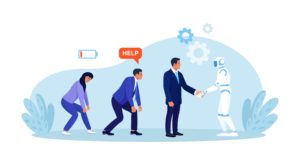Artificial intelligence (AI) isn’t a static tool. It’s not a product you buy once and forget about. It’s a dynamic, constantly evolving capability that improves almost daily—learning from new data, integrating fresh research, and becoming more useful, more precise, and more powerful with every iteration. This rate of improvement isn’t just impressive—it’s unprecedented.
For industries like finance, healthcare, manufacturing, and logistics, the compounding progress of AI means one thing: what seemed impossible last year is routine today, and what’s groundbreaking now will be table stakes tomorrow.
Let’s explore why AI keeps getting better, what that means for users, and why keeping pace with the evolution of AI is no longer optional—it’s essential.
AI Feeds on Data—and There’s More Every Day
AI learns from data. The more high-quality data an AI system consumes, the better it becomes at understanding, predicting, and assisting. Thanks to digitization, cloud computing, and IoT devices, the volume of data available for training and fine-tuning AI models is growing exponentially.
This means AI systems aren’t just learning from their initial training—they’re continually improving through feedback loops. For example:
- Search engines get smarter by analyzing what users click.
- Voice assistants improve their speech recognition by listening to more voices.
- Recommendation engines refine their suggestions based on user behavior.
In the world of finance, AI tools are learning from millions of filings, earnings calls, and market movements to deliver sharper, more timely insights. In medicine, AI models trained on clinical records, radiology images, and genomics are making diagnoses faster and more accurately than ever.
The more data AI consumes, the better it gets—and there’s no end in sight.
Research Advances Are Accelerating
AI isn’t just improving because of data—it’s improving because of research. Each year brings dozens of breakthroughs in model architectures, training techniques, and optimization strategies.
From the leap to transformer-based models like GPT and BERT, to more efficient architectures like LLaMA and Mistral, the rate of advancement in AI science is outpacing even Moore’s Law. These breakthroughs are then quickly turned into open-source projects, commercial applications, and API-based tools available to developers and businesses.
The speed of adoption is also remarkable. It used to take years for academic discoveries to reach the enterprise. Now, companies can integrate the latest AI models within weeks—or even days—of their release.
This constant improvement isn’t just theoretical. It’s reshaping products in real time. AI-generated text, once clunky and error-prone, is now coherent, persuasive, and stylistically adaptable. Image generation tools are creating photorealistic scenes in seconds. Financial AI can extract, analyze, and interpret company fundamentals faster than any human.
The floor is rising—and the ceiling is disappearing.
Models Are Becoming More Specialized
As AI matures, it’s becoming more tailored to specific tasks and industries. Rather than trying to build one model that does everything, developers are increasingly fine-tuning AI for targeted use cases:
- Legal AI trained on case law and contracts.
- Financial AI trained on SEC filings and earnings transcripts.
- Healthcare AI trained on medical literature and EHR data.
This specialization means AI tools are getting not just faster, but smarter—more accurate, more context-aware, and more useful in high-stakes domains. They don’t just generate outputs; they understand nuance, recognize jargon, and surface insight.
This is a major shift from the early days of AI, when general-purpose models produced vague or unreliable outputs. Today’s best systems can outperform domain experts on specific, narrow tasks—while still deferring to human judgment on big-picture decisions.
Feedback Loops Drive Continuous Refinement
The best AI tools today don’t just improve at the lab—they improve in production. Thanks to reinforcement learning, human-in-the-loop systems, and real-world usage data, AI can learn and adjust over time based on how it’s used.
This means the more an organization uses AI, the more value it gets. If a financial research platform uses AI to summarize filings, each correction or edit by a human analyst helps refine the model’s future outputs. If a call center uses AI for customer support, each resolved ticket helps train the system to resolve the next one more quickly.
This feedback loop creates a compounding advantage: the more you use AI, the better it works for you.
The Ecosystem Is Expanding
AI improvement isn’t limited to the models themselves—it’s also happening in the ecosystem around them:
- Better hardware: GPUs, TPUs, and custom AI chips allow faster training and inference.
- More accessible tools: APIs, no-code platforms, and AI assistants make it easier for non-experts to use advanced AI.
- More open collaboration: Communities like Hugging Face, GitHub, and ArXiv allow developers to share ideas and iterate faster.
All of this means businesses of any size can access cutting-edge AI capabilities that were once the domain of only the largest tech firms.
Staying Ahead in a World of Constant Improvement
The most important takeaway? AI is not static. If you’re using the same AI tools today that you were 12 months ago, you’re already behind.
To stay competitive, individuals and organizations need to continually reassess how they’re using AI. What new capabilities are available? How can those be applied to eliminate inefficiencies, reduce risk, or gain new insight?
Adopting AI is no longer a one-time decision—it’s an ongoing process of learning, adapting, and upgrading. The companies that succeed won’t just be the ones who adopt AI—they’ll be the ones who keep adapting as AI improves.
Conclusion
AI is not a trend—it’s a transformation. And like all transformative technologies, it evolves rapidly. With every passing month, AI models become smarter, faster, and more specialized. They learn from more data, integrate better into workflows, and extend their utility into new domains.
The organizations and professionals who embrace this pace of improvement—who stay curious, stay agile, and stay up to date—will be the ones who gain the most from AI’s potential. Those who wait risk being left behind.
AI is improving. Constantly. The only question is: are you improving with it?




